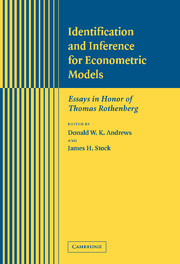Book contents
- Frontmatter
- Contents
- List of Contributors
- Preface
- Part I Identification and Efficient Estimation
- Part II Asymptotic Approximations
- 8 Asymptotic Expansions for Some Semiparametric Program Evaluation Estimators
- 9 Higher-order Improvements of the Parametric Bootstrap for Markov Processes
- 10 The Performance of Empirical Likelihood and Its Generalizations
- 11 Asymptotic Bias for GMM and GEL Estimators with Estimated Nuisance Parameters
- 12 Empirical Evidence Concerning the Finite Sample Performance of EL-type Structural Equation Estimation and Inference Methods
- 13 How Accurate is the Asymptotic Approximation to the Distribution of Realised Variance?
- 14 Testing the Semiparametric Box–Cox Model with the Bootstrap
- Part III Inference Involving Potentially Nonstationary Time Series
- Part IV Nonparametric and Semiparametric Inference
8 - Asymptotic Expansions for Some Semiparametric Program Evaluation Estimators
Published online by Cambridge University Press: 24 February 2010
- Frontmatter
- Contents
- List of Contributors
- Preface
- Part I Identification and Efficient Estimation
- Part II Asymptotic Approximations
- 8 Asymptotic Expansions for Some Semiparametric Program Evaluation Estimators
- 9 Higher-order Improvements of the Parametric Bootstrap for Markov Processes
- 10 The Performance of Empirical Likelihood and Its Generalizations
- 11 Asymptotic Bias for GMM and GEL Estimators with Estimated Nuisance Parameters
- 12 Empirical Evidence Concerning the Finite Sample Performance of EL-type Structural Equation Estimation and Inference Methods
- 13 How Accurate is the Asymptotic Approximation to the Distribution of Realised Variance?
- 14 Testing the Semiparametric Box–Cox Model with the Bootstrap
- Part III Inference Involving Potentially Nonstationary Time Series
- Part IV Nonparametric and Semiparametric Inference
Summary
ABSTRACT
We investigate the performance of a class of semiparametric estimators of the treatment effect via asymptotic expansions. We derive approximations to the first two moments of the estimator that are valid to “second order.” We use these approximations to define a method of bandwidth selection. We also propose a degrees of freedom–like bias correction that improves the secondorder properties of the estimator but without requiring estimation of higher-order derivatives of the unknown propensity score. We provide some numerical calibrations of the results.
INTRODUCTION
In a series of classic papers Tom (Rothenberg 1984a,b,c, 1988) introduced Edgeworth expansions to a broad audience. His treatment of the generalized least-squares estimator (1984b) in particular was immensely influential because it dealt with an estimator of central importance and the analysis was both deep and precise, but comprehensible. This is in contrast with some of the more frenzied publications about Edgeworth expansions that had hitherto appeared in econometrics journals. The use of Basu's theorem in that paper to establish the independence of the correction terms from the leading term is a well-known example of his elegant work. The reviewpaper (1984a) was also very influential and highly cited.
It is our purpose here to present asymptotic expansions for a class of semiparametric estimators used in the program evaluation literature. We have argued elsewhere (Linton 1991, 1995; Heckman et al. 1998) that the first-order asymptotics of semiparametric procedures can be misleading and unhelpful. The limiting variance matrix of the semiparametric procedure Σ does not depend on the specific details of how the nonparametric function estimator ĝ is constructed, and thus sheds no light on how to implement this important part of the procedure.
Information
- Type
- Chapter
- Information
- Identification and Inference for Econometric ModelsEssays in Honor of Thomas Rothenberg, pp. 149 - 170Publisher: Cambridge University PressPrint publication year: 2005
Accessibility standard: Unknown
Why this information is here
This section outlines the accessibility features of this content - including support for screen readers, full keyboard navigation and high-contrast display options. This may not be relevant for you.Accessibility Information
- 25
- Cited by
